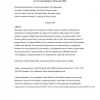Free Online Productivity Tools
i2Speak
i2Symbol
i2OCR
iTex2Img
iWeb2Print
iWeb2Shot
i2Type
iPdf2Split
iPdf2Merge
i2Bopomofo
i2Arabic
i2Style
i2Image
i2PDF
iLatex2Rtf
Sci2ools
MANSCI
2007
2007
Resolving Inconsistencies in Utility Measurement Under Risk: Tests of Generalizations of Expected Utility
This paper explores biases in the elicitation of utilities under risk and the contribution that generalizations of expected utility can make to the resolution of these biases. We used five methods to measure utilities under risk and found clear violations of expected utility. Of the theories studies, prospect theory was most consistent with our data. The main improvement of prospect theory over expected utility was in comparisons between a riskless and a risky prospect (riskless-risk methods). We observed no improvement over expected utility in comparisons between two risky prospects (risk-risk methods). An explanation why we found no improvement of prospect theory over expected utility in risk-risk methods may be that there was less overweighting of small probabilities in our study than has commonly been observed.
| Added | 16 Dec 2010 |
| Updated | 16 Dec 2010 |
| Type | Journal |
| Year | 2007 |
| Where | MANSCI |
| Authors | Han Bleichrodt, Jose Maria Abellan-Perpiñan, Jose Luis Pinto-Prades, Ildefonso Mendez-Martinez |
Comments (0)

